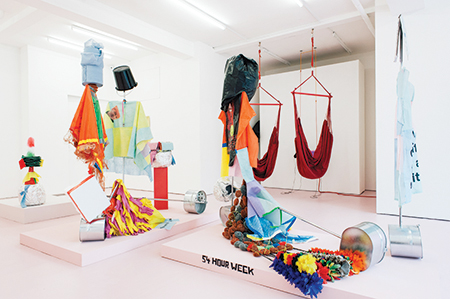Oreet Ashery
Waterside Contemporary, London, UK
Waterside Contemporary, London, UK

At the back of an anonymous garden, a woman lies on a pile of planks, silver foil on her feet and hands, an apple stuffed in her mouth, the hand of a man with prehistoric features resting proprietorially on her shoulder. A voice-over commences in reassuringly patrician tone: ‘Anybody can own a pig.’ Over the few minutes of Oreet Ashery’s How to Kill a Pig (2013–14), an expanding pink and red vortex is imposed over the figures, digitally mincing them. The language of the voice-over – which summarises the artist’s research into the legal conditions for sacrificing a pig during a performance – strays from bureaucratic specificity towards a more nameless menace. ‘Once your pig is dead, you can do what you want with it.’ At Waterside Contemporary, the video screen was suspended from ropes, to be watched from a narrow fabric Womb Hammock (2014); beside it, a plaster cast of a pig is wedged mid-air in a crevice, weightless but constrained. Across the gallery, a large black and white print of an image pulled from Google curled into a standing cone depicts a person cuffed into a ‘hog-tie’: variously used for handling livestock, torture and sexual fetish.
Sex lingers in this show like a bad aftertaste. A seemingly banal photograph, Untitled (Lollipop) (2014), of a man’s lips puckering around a multi-coloured ice-lolly hangs adjacent to one documenting a ‘tea-bagging’ from Ashery’s performance series ‘Party for Freedom’ (2013–ongoing). Sturtevant once described pornography as having a ‘funny-fun’ quality. Ashery seems judiciously suspicious of fun – here, as in previous works, she explores the ambivalent values of gratification, release, license. (‘Party for Freedom’ borrowed its title from that of anti-Islamic Dutch politician Geert Wilder’s Partij voor de Vrijheid.) The voice-over of How to Kill a Pig reports that an animal cannot be privately slaughtered in a state of undue stress, pain or excitement. If excitement, then, is a kind of cruelty, where does that leave the liberatory potential of pleasure? The title of one work on show – The World Doesn’t Have to Be How You Want It To Be – offers a blunt answer.
Whilst the exhibition hints at what Carol J. Adams’s 1990 book called The Sexual Politics of Meat, Ashery’s primary interest in livestock is as a broader metaphor for stigmatized social groups. Such communities were directly addressed by a grouping of ten sculptural assemblages, ‘The Un/Clean’ series (2014), which dominated the space.
Constructed from cleaning materials, a typical work consisted of a metal mop stood atop a bucket, rolls of blue, industrial kitchen-roll piled up for a head, dressed in a kind of poncho made from orange toxic waste disposal bags and a necklace of rubber gloves. The costumes had been made and worn by members of Freedom from Torture, UK Lesbian & Gay Immigration Group and the charity Portugal Prints whilst participating in Ashery’s previous performances, including The World is Flooding (2014) at Tate Modern in July – a frenetic musical adaptation of Vladimir Mayakovsky’s Mystery-Bouffe (1918–21) describing the struggle for dominance of groups of Clean and Unclean after a flood. A certain shift of energy is sometimes unavoidable in the transition from theatrics to objects (the poncho draped mops almost resembled puppets, waiting to be played with) and without the supporting narrative of the Tate performance ‘The Un/Clean’ series appears more simply as a carnival of corporate cleaners. Nevertheless, the figure of the cleaner – low-paid, low-visibility, frequently migrant and implicated in the symbolic exchange between purity and danger – is an effective stand-in for Ashery’s sometime collaborators. Conceptually, then, a pretty neat trope. But these works possessed a visual neatness too, which did little to convey viscerally the experience of the labour of cleaning, let alone the experience of social degradation or exclusion. The press release’s insistence (via Mayakovsky) that ‘The Unclean Are Rising Again! They Exist!’ was hard to square with the sterile prettiness of the pastel dust cloths, glittering metallic pan scourers, gleaming chrome handles and pristine patterned J-cloths.
What seemd at first like a misstep came to look, however, like an intentional wrong-footing; the astringent quality of the harshly lit installation and its odd lack of mess a rebuff to a lazy cliché of what art made about and by ‘The Un/Clean’ should look like. Maybe it is impossible to fully appraise these works beyond the meaning they hold to Ashery’s collaborators – no less urgent, I suppose, for not being obviously accessible to the outside viewer. Another video, Winking Series I (2014), installed discreetly in the surface of a plinth, documented Ashery’s collaborators winking in succession at the camera, communicating their mutual identification within a bonded group. At a push, we’re all animals with a language: this show was a reminder that, even so, we don’t all always necessarily speak the same one.























